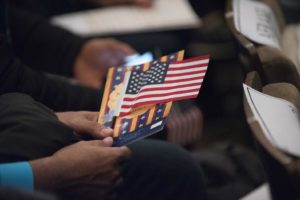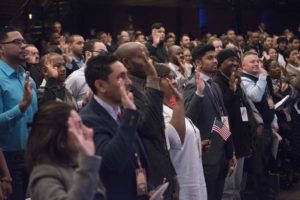Supreme Justice Through a Museum
How often do you think a Supreme Court Justice volunteers to participate in a museum program? Probably not very often. But when a museum offers an important program for an important constituency that is under threat, a justice might just take notice.

Supreme Court Justice Ruth Bader Ginsburg saw an article in the New York Times about the New-York Historical Society’s Citizenship Project, a 24-hour program that prepares adults to become American citizens by passing the United States Citizenship and Immigration Service’s Naturalization Test. According to the Times, Justice Ginsburg read about the program and “thought it was a grand idea. So, I wrote to N.Y.H.S. and said if ever I am in town when they had a naturalization ceremony, I would be glad to participate.”
The New-York Historical Society has been hosting naturalization ceremonies for years, but in summer 2017 it joined with the City University of New York’s Citizen Now! program to offer the free Citizen Project course to green card holders. The course focuses on the civics portion of the naturalization test, and makes use of the museum’s collections, documents, exhibitions and other resources to help students understand the rights and responsibilities of citizenship. In a just-published Journal of Museum Education article, “Museums as Vital Resources for New Americans: The Citizenship Project,” New-York Historical Society’s Vice President for Education Mia Nagawiecki explains that although some immigrant support services offer classes for those seeking citizenship, they rarely go into depth; “…If civics is taught as little more than vocabulary, or neglected altogether, it gives the impression that the information on that portion of the test is not as important to productive citizenship as it is.”
Mia argues, “By studying the Constitution and Amendments in the context of the times in which they were drafted and ratified, participants come to understand the form and function of the three branches of government, as well as the protections and obligations of citizenship. Through an exploration of critical chapters in American history, the Citizenship Project demonstrates that active debate and citizen action fundamentally shaped our nation at its founding and continues to today, underscoring the need for something deeper than rote learning of facts for a civics exam. Because participants leave with a strong understanding of the United States’ past, they will be more active in creating the future America.”

Answers to the civics questions on the Naturalization Test can certainly be memorized, but they have very little meaning without context. Moreover, it is unlikely that most native-born Americans could answer them without studying. Check out test questions here; the New-York Historical Society has posted some so that you can test your own knowledge of civics and American history.
In her article, Mia goes on to say that “The museum’s role does not end once students complete the course. We continue to serve as a resource by providing practice test days as well as introducing our students to services from various community-based organizations and government agencies, including voter registration, job fairs, and entrepreneurial support, beginning during the course and continuing beyond taking the oath.”
“We are a nation made strong by people like you,” said Justice Ginsburg to the new American citizens in the naturalization ceremony at the museum. The museum contributes to this collective strength through the route it has created to citizenship.
Cynthia Robinson is the director of Museum Studies at Tufts University and the Editor-in-Chief of the Journal of Museum Education.
This blog post first appeared as an article in the Tufts Museum Studies e-Newsletter in April 2018. You can read the JME article mentioned in the post and the rest of the Civic Engagement issue by becoming a MER member today.

